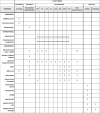The scientific rationale and study protocol for the DPP3, Angiotensin II, and Renin Kinetics in Sepsis (DARK-Sepsis) randomized controlled trial: serum biomarkers to predict response to angiotensin II versus standard-of-care vasopressor therapy in the treatment of septic shock
- PMID: 38475822
- PMCID: PMC10935947
- DOI: 10.1186/s13063-024-07995-0
The scientific rationale and study protocol for the DPP3, Angiotensin II, and Renin Kinetics in Sepsis (DARK-Sepsis) randomized controlled trial: serum biomarkers to predict response to angiotensin II versus standard-of-care vasopressor therapy in the treatment of septic shock
Abstract
Background: Data to support the use of specific vasopressors in septic shock are limited. Since angiotensin II (AT2) was approved by the Food and Drug Administration in 2017, multiple mechanistically distinct vasopressors are available to treat septic shock, but minimal data exist regarding which patients are most likely to benefit from each agent. Renin and dipeptidyl peptidase 3 (DPP3) are components of the renin-angiotensin-aldosterone system which have been shown to outperform lactate in predicting sepsis prognosis, and preliminary data suggest they could prove useful as biomarkers to guide AT2 use in septic shock.
Methods: The DARK-Sepsis trial is an investigator-initiated industry-funded, open-label, single-center randomized controlled trial of the use of AT2 versus standard of care (SOC) vasopressor therapy in patients admitted to the intensive care unit (ICU) with vasodilatory shock requiring norepinephrine ≥ 0.1 mcg/kg/min. In both groups, a series of renin and DPP3 levels will be obtained over the first 24 h of treatment with AT2 or SOC. The primary study outcome will be the ability of these biomarkers to predict response to vasopressor therapy, as measured by change in total norepinephrine equivalent dose of vasopressors at 3 h post-drug initiation or the equivalent timepoint in the SOC arm. To determine if the ability to predict vasopressor response is specific to AT2 therapy, the primary analysis will be the ability of baseline renin and DPP3 levels to predict vasopressor response adjusted for treatment arm (AT2 versus control) and Sequential Organ Failure Assessment (SOFA) scores. Secondary outcomes will include rates of acute kidney injury, need for mechanical ventilation and kidney replacement therapy, lengths of stay in the ICU and hospital, ICU and hospital mortality, and rates of prespecified adverse events.
Discussion: With an armamentarium of mechanistically distinct vasopressor agents now available, sub-phenotyping patients using biomarkers has the potential to improve septic shock outcomes by enabling treatment of the correct patient with the correct vasopressor at the correct time. However, this approach requires validation in a large definitive multicenter trial. The data generated through the DARK-Sepsis study will prove crucial to the optimal design and patient enrichment of such a pivotal trial.
Trial registration: ClinicalTrials.gov NCT05824767. Registered on April 24, 2023.
Keywords: Angiotensin II; Biomarker; DPP3; Dipeptidyl-peptidase 3; Renin; Septic shock; Vasopressor.
© 2024. The Author(s).
Conflict of interest statement
The authors declare that they have no competing interests.
Figures

Similar articles
-
Shock prediction with dipeptidyl peptidase-3 and renin (SPiDeR) in hypoxemic patients with COVID-19.J Crit Care. 2025 Feb;85:154950. doi: 10.1016/j.jcrc.2024.154950. Epub 2024 Nov 14. J Crit Care. 2025. PMID: 39546997
-
Monitoring circulating dipeptidyl peptidase 3 (DPP3) predicts improvement of organ failure and survival in sepsis: a prospective observational multinational study.Crit Care. 2021 Feb 15;25(1):61. doi: 10.1186/s13054-021-03471-2. Crit Care. 2021. PMID: 33588925 Free PMC article.
-
Vasopressor Therapy in the Intensive Care Unit.Semin Respir Crit Care Med. 2021 Feb;42(1):59-77. doi: 10.1055/s-0040-1710320. Epub 2020 Aug 20. Semin Respir Crit Care Med. 2021. PMID: 32820475
-
Novel Vasopressors in the Treatment of Vasodilatory Shock: A Systematic Review of Angiotensin II, Selepressin, and Terlipressin.J Intensive Care Med. 2020 Apr;35(4):327-337. doi: 10.1177/0885066618818460. Epub 2018 Dec 18. J Intensive Care Med. 2020. PMID: 30563433
-
Role of angiotensin II in treatment of refractory distributive shock.Am J Health Syst Pharm. 2019 Jan 16;76(2):101-107. doi: 10.1093/ajhp/zxy014. Am J Health Syst Pharm. 2019. PMID: 31361800 Review.
Cited by
-
Shock prediction with dipeptidyl peptidase-3 and renin (SPiDeR) in hypoxemic patients with COVID-19.J Crit Care. 2025 Feb;85:154950. doi: 10.1016/j.jcrc.2024.154950. Epub 2024 Nov 14. J Crit Care. 2025. PMID: 39546997
-
Vasopressin and its analogues in patients with septic shock: holy Grail or unfulfilled promise?Crit Care. 2025 Jul 29;29(1):333. doi: 10.1186/s13054-025-05540-2. Crit Care. 2025. PMID: 40731360 Free PMC article. Review.
-
Angiotensin II in Catecholamine-Refractory Shock: A Systematic Review and Exploratory Analysis of the Angiotensin II for the Treatment of High-Output Shock (ATHOS-3) Trial.Cureus. 2025 Jun 22;17(6):e86546. doi: 10.7759/cureus.86546. eCollection 2025 Jun. Cureus. 2025. PMID: 40548153 Free PMC article. Review.
References
-
- Szerlip H, Bihorac A, Chang S et al: Effect of disease severity on survival in patients receiving angiotensin II for vasodilatory shock [abstract]. Crit Care Med. 2018;46(1):3.
Publication types
MeSH terms
Substances
Associated data
LinkOut - more resources
Full Text Sources
Medical
Miscellaneous

